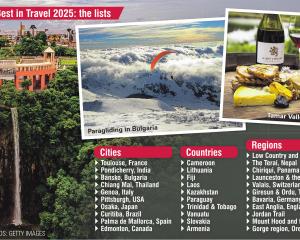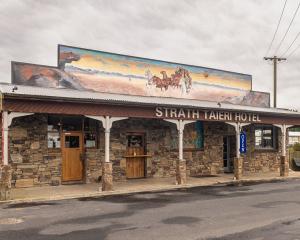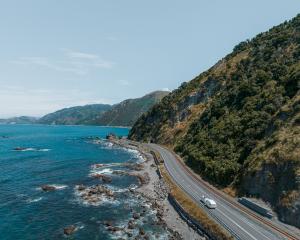Dunedin’s Rudy Adrian takes in the Abel Tasman National Park on a recent holiday.
"Make sure you take the left-hand track and we’ll pick you up at Anchorage at 5 o’clock."
That’s the advice from Abel Tasman Sea Shuttles skipper Michael Behringer as I walk down the ramp from the passenger catamaran Adelle II and on to Medlands Beach, for my day walk along part of the Abel Tasman National Park coastal track.

It’s a good tip to give to a visitor to the popular park near Nelson, as there are many different tracks taking hikers through the regenerating native forest and tree ferns that cover much of the scenic coastline.
After about a 20-minute walk, the track leads me to a swing bridge crossing the Falls River. The view upstream reveals the rugged hinterland of the park, covered in a forest of rimu and beech trees, where some believe the rare, possibly extinct, South Island kokako may have its last refuge.
Earlier, Mr Behringer told me of the predator trapping and revegetation programmes, towards which Abel Tasman Sea Shuttles has contributed the equivalent of about half a million dollars in transportation at reduced rates over the past 20 years.
"We take a lot of the volunteers in, doing the trapping programmes, and it makes you feel good you’re being involved in something that’s improving the park," he said.
One of the highlights has been the release of 20 kaka into the national park two years ago. Initially housed in an aviary at Bark Bay to acclimatise them to their new surroundings, the birds are now a feature of the wider area.
"I recently talked to a couple who had been in Bark Bay camping and the kakas woke them up in the morning, which I thought was fantastic," Mr Behringer said.
Eventually, I arrive at Torrent Bay, which is about the halfway point of my walk and is living up to its name. The high tide has turned and the sun-warmed waters of the lagoon are rushing out to create a natural hydroslide for those game enough to jump into the current.
Torrent Bay is one of several places along the park’s coast with a cluster of privately owned cribs. Several families are out enjoying the spit of sand that separates the sea and lagoon.
"Look, there’s a stingray" one woman says and, indeed, we can see a grey body larger than a bath mat slowly gliding through the clear waters of the lagoon.
Stingrays should be respected because of their poisonous barb. But just five minutes later, I’m a little surprised to see the person who spotted it jumping in.
Out on the beach, another tourist venture unloads half a dozen holidaymakers from its small, outboard-motored craft, with passengers having to disembark in knee-deep water.
When I later spoke to Abel Tasman Sea Shuttles director Greg Knapp, he told me the company prides itself on having built its own large twin-engined catamarans, each equipped with a ramp to allow tourists to embark and disembark at most beaches without getting their feet wet.
To reduce damage to the sea floor, the propellers are specially designed to tilt to one side of the vessel to allow them to operate in very shallow water without churning up the bottom.
Mr Knapp says he joined the family-owned business about 20 years ago, helping his father, Keith Knapp, build the craft they use today.
"Because we can build our own stuff, we do. All of our equipment is built specifically for the job we’re doing — you can’t just buy what we have off the shelf."

"You can walk around and take a photo unobstructed and you’re not required to wear a life jacket unless there’s an emergency. You’ve got toilet facilities on board and most of our boats have refreshments.
"So if you compare apples with apples, there’s not really any competition, so to speak."
However, the massive drop-off in tourism since Covid-19 closed New Zealand’s borders means the company’s big boat, which saw about five months of service most summers, is almost redundant.
"Last year, we got to use it for about 10 days. This year, we haven’t even considered getting it out of its pen."
Mr Knapp says he thinks the drop in tourists this summer is due to people having already explored their own backyard last summer.
"Those that were going to travel around and have a look at the country have already done it, bar a few, and I believe that until the international borders open, tourism in New Zealand is basically on hold.
"We’re carrying this year less than half of what we did last year, and last year was a bad year."
The company also operated a division offering guided kayaking trips along the coast, with paddlers being able to pull up at the many small golden sand beaches not normally called in on by boats.
Kayaking was "a huge market" but the kayaks are in storage this summer due to the lack of demand, he says.
As a result, the total number of staff employed has more than halved, down to about 15 this season.
"Every time I get to drive the boat, I’ll say to everyone on board ‘thank you very much for your support and coming and spending your time and money with us, because we really need it’."
It’s very much a family business, with Greg Knapp following in his father’s footsteps, his nephew now working as a skipper and his 14-year-old son also already doing some crewing.
"I say it’s the easiest job in the world, because all you’ve got to do is be polite to people and the national park does the rest of it for you."

He shares Mr Knapp’s
passion for the area.
"If you’re living here, you want to show it off to people."

At the other side, I meet some hikers who have waited for the waters to recede before crossing the lagoon. They talk of having battled thick mud, risking losing their jandals in the process.
For me it’s just a few more hundred metres to Anchorage beach, arriving over an hour before I’m due to be picked up.
"Isn’t it beautiful?" another day tripper says. She’s right. Anchorage is idyllic, with gentle waves breaking on the golden sand and half a dozen sailing yachts moored out on the turquoise waters of the bay.

The city of Nelson is visible across Tasman Bay and I’ve now got reception back on my phone.
Half an hour later I’m back at Anchorage and Mr Behringer lowers the ramp from Adelle II to allow several walkers and myself to get back on board for our ride back to Kaiteriteri, where we started this morning.
I ask him how he feels having Abel Tasman National Park as his place of work.
"See the bare feet and the shorts? That’s been me since a kid. I love it."













